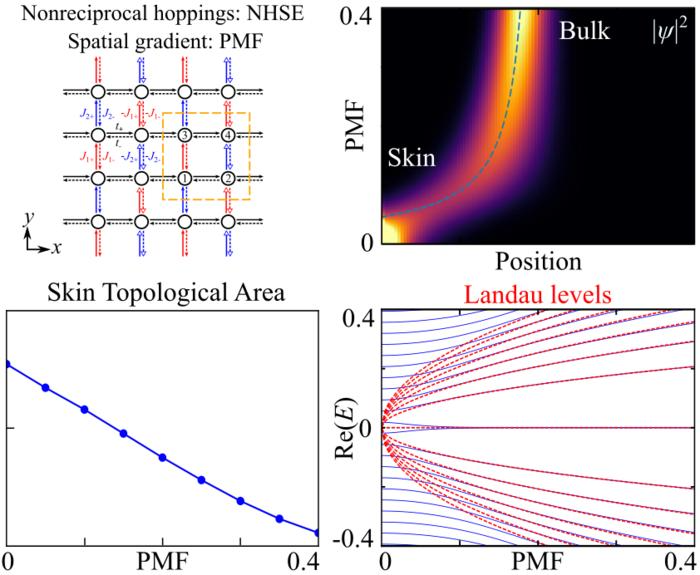Reviewed by Lexie CornerMay 20 2024
Researchers from Nanyang Technological University and The Chinese University of Hong Kong found that skin states can be suppressed into the bulk by implementing the pseudomagnetic field. The study has been published in Science Bulletin.
 By implementing a pseudomagnetic field (PMF) in the array with non-Hermitian skin effect (NHSE), the team from Singapore and Hong Kong discovered that the skin states can be suppressed into the bulk. The skin topological area is also suppressed, followed by recovery of flat energy levels (Landau levels). Image Credit: ©Science China Press
By implementing a pseudomagnetic field (PMF) in the array with non-Hermitian skin effect (NHSE), the team from Singapore and Hong Kong discovered that the skin states can be suppressed into the bulk. The skin topological area is also suppressed, followed by recovery of flat energy levels (Landau levels). Image Credit: ©Science China Press
Professors Baile Zhang of Nanyang Technological University's School of Physical and Mathematical Sciences and Haoran Xue of The Chinese University of Hong Kong's Department of Physics lead this study.
Wave intensities tend to localize at the system boundary, a phenomenon named the non-Hermitian skin effect. This is due to the presence of non-Hermitian components. Topology shields the skin's behavior, making small changes insensitive to it. However, recent research has demonstrated that actual magnetic fields can inhibit the non-Hermitian skin effect.
Zhang, Xue, and Zhang’s graduate student Hau Tian Teo wondered, “Can a ‘fake’ magnetic field–pseudo magnetic field–also suppress the non-Hermitian skin effect?”
Then, using a two-dimensional lattice array, the team ran theoretical calculations to examine the topology and behavior of the skin's movement.
This movement from skin to bulk can be precisely traced by a theoretically predicted trajectory.
Hau Tian Teo, Graduate Student, School of Physical and Mathematical Sciences, Nanyang Technological University
Both movement movement and suppression reflect the decrease in the topological number.
The researchers discovered that even though this is a non-Hermitian environment, the pseudomagnetic field can recover flat energy levels, just like in a Hermitian system.
“Together with the precise location of the state, we can even trace its flat and quantized energy levels. This could contribute to the precise localization of states in space and energy,” said Xue.
These exciting new results provide a time-reversal invariant way to control non-Hermitian systems. As our ‘fake’ magnetic field is unchanged if we reverse the arrow of time, this protocol could be promising in controlling classical wave devices that are able to host the non-Hermitian skin effect but inert to magnetic fields.
Baile Zhang, Professor, School of Physical and Mathematical Sciences, Nanyang Technological University
Journal Reference:
Teo, T. H., et al. (2024) Pseudomagnetic suppression of non-Hermitian skin effect. Science Bulletin. doi.org/10.1016/j.scib.2024.04.023.